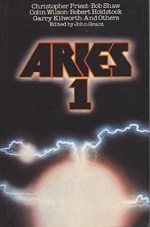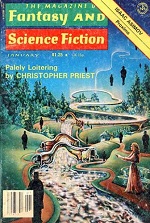Novel
Christopher Priest
writer
- Filter: Show all works, including those with no time phenomena.
- Found: 5 results in 4.17ms
Novel
Novelette
An Infinite Summer
- by Christopher Priest
- in Andromeda, edited by Peter Weston (Orbit, May 1976)
For purposes that only they can know, people from the future—Thomas Lloyd calls them “freezers”—put a small number of people into a kind of suspended animation. Nobody can see the frozen except for those who have been previously frozen and then thawed. Thomas himself is among this select group: frozen in 1903 on the verge of proposing to his beloved Sarah; unfrozen shortly before World War II, at which point he can but view his still-frozen Sarah.
Thomas James Lloyd, straw hat raised in his left hand, his other hand reaching out. His right knee was slightly bent, as if he were about to kneel, and his face was full of happiness and expectation. A breeze seemed to be ruffling his hair, for three strands stood on end, but these had been dislodged when he removed his hat. A tiny winged insect, which had settled on his lapel, was frozen in its moment of flight, an instinct to escape too late.

Short Story
The Agent
- by Christopher Priest and David Redd
- in Aries, 1, edited by John Grant (David and Charles, 1979)
Egon Rettmer—citizen of neutral Silte, but an agent for the Nord-Deutschland in their war against the Masurians—uses time travel for his communiques and, as he realizes on the eve of the N-D invasion, there’s the potential to use it for more, maybe even to get a good start with that entrancing visitor, Heidi.
She was behaving towards him, literally, as if he had been in two places at once. . . as if, this morning, he had met her and told her of the escape plans he had only half started to form a few minutes ago!

Short Story
Palely Loitering
- by Christopher Priest
- Magazine of Fantasy and Science Fiction, January 1979
At age ten, Mykle jumps off the time-flux bridge at a sharp angle and goes far into the future where he sees a lovely girl named Estyll, and as he grows older, he is drawn to the future and to her over and over again.
One of these traversed the Channel at an angle of exactly ninety degrees, and to walk across it was no different from crossing any bridge across any ordinary river.
One bridge was built slightly obtuse of the right-angle, and to cross it was to climb the temporal gradient of the flux-field; when one emerged on the other side of the Channel, twenty-four hours had elapsed.
The third bridge was built slightly acute of the right-angle, and to cross to the other side was to walk twenty-four hours into the past. Yesterday, Today and Tomorrow existed on the far side of the Flux Channel, and one could walk at will among them.



